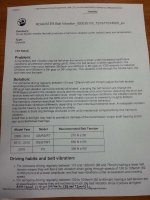BRP RECOMMENDED BELT TENSIONS for SPYDERS 2008 thru 2014 YEAR BUILDS
NOTE : Conversion Tool.
The following URL leads to a very useful conversion tool for converting N (Newton Metres) to LBF (Pounds Force).
http://www.tiniusolsen.com/resource-center/n-lbf.html
For those that prefer to use thier fingers you may use the following Formula, N = 4.44882 LBF
This conversion is done so those without an extremely expensive "Sonic Guage" may instead use the very reasonably priced "Krikit Guage" which reads in pounds force (LBF) to check the belt tension on thier own Spyder.
BRP RECOMMENDED BELT TENSIONS
NOTE: The following information has been sourced from BRP service manuals or service bulletins only
1. Spyders Year Model 2008 through 2012
BRP Recommended Belt Tension
450 N +/- 150 N
Converted to pounds force (LBF)
450 N = 101 LBF
150 N = 34 LBF
Therefore the Drive Belt Tension should measure between
67 LBF to 135 LBF
2. Spyders Year Models 2013
BRP Recommended Belt Tension
1050 N +/- 150 N
Converted to pounds force (LBF)
1050 N = 237 LBF
150 N = 34 LBF
Therefore the Drive Belt Tension should measure between
203 LBF to 271 LBF
3. Spyder Year Models 2014
BRP Recommended Belt Tension
1050 N +/- 150 N
Converted to pounds force (LBF)
1050 N = 237 LBF
150 N = 34 LBF
Therefore the Drive Belt Tension should be between
LBF is 203 LBF to 271 LBF
.......................................
When checking or adjusting the Drive Belt Tension you should also check the gap between the inner edge of the drive belt and the edge of the flange on the rear pulley. This gap should be between 1mm and 5mm.
Tension required when re-torquing the axle nut is 225 N.
Note:
1. Measurements should be taken on topside of the belt midway between the front and rear sprocket. The rear wheel should lifted off the ground and drive belt tension parts should be at room temperature.
2.The lifting point must be on the frame NOT under the rear shock absorber.
3. For early model Spyders (2008/9) it was stated that measurements were to be checked at 6 different points. ie - line up a spoke on rear wheel with swing arm - check tension. Spin wheel till next spoke aligns with swingarm - check tension and so on. Once tensions checked with all 3 spokes aligned with swing arm repeat the process with the midway points between spokes aligned with swing arm.
BRP even have a decal (P/N 704903694) with required tensions listed that can be afixed to your Spyder as a reminder.
I've put this information in the hope that it may clarify the differences between individual views (as seen on many forums or verbally shared) compared to what BRP has documented as the required Drive Belt Tension for our Spyders.
Hopefully this information may be of some assistance to all my Spyder Owners.
Regards
Kenn

